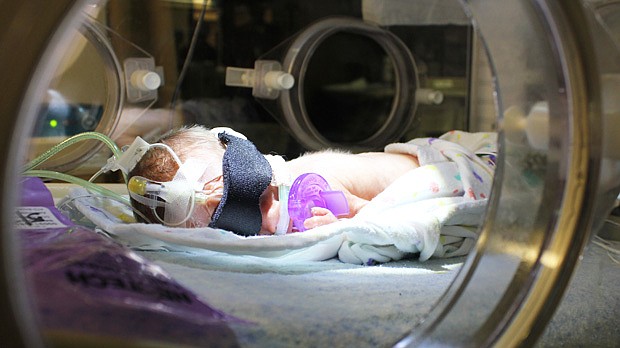- July 26, 2024
-
-
Loading

Loading

Reaching rubber-gloved hands through the arm-sized holes of the thick plastic incubator walls, a Winnie Palmer NICU nurse cups the wire-laden crown of newborn baby Kevin Skoog’s head with her left hand. Her right places a stethoscope on Kevin’s peach-fuzz covered back, checking the rhythm of his teeny-tiny heart.
Basking in the warmth of the incubator’s warm yellow spotlight, premature born Kevin – nicknamed “Peanut” by his parents for his small size – uses his little fingers to grasp the large purple pacifier protruding from his mouth while the nurse works. Between the purple plastic of the pacifier, dark cloth-constructed shades covering his eyes and thick tube settled in under his nose, the only distinguishable characteristic above Kevin’s shoulders are wisps of light brown hair sticking out from amongst the wires affixed to his forehead.
To learn more about Winnie Palmer Hospital for Women and Babies, visit orlandohealth.com/winniepalmerhospital. To learn about the March of Dimes and what the organization is doing to end early elective deliveries, visit marchofdimes.com
Kevin is one of a decreasing number of premature born babies needing care from Orlando’s Winnie Palmer Hospital for Women and Babies’ Neonatal Intensive Care Unit (NICU). From 2011 to 2012, the number of late pre-term babies being born and needing stays in the NICU have dropped by 50 percent. Winnie Palmer doctors credit the drop to hard-stop guidelines restricting early elective deliveries (EED), which has helped moms deliver healthier babies.
That means 50 percent less families leaving their babies in the hospital when they go home, and half as many moms sleeping in chairs waiting to see their newborns, said registered nurse Lorraine Parker, the administrator for patient care at the hospital, and one of the people leading the change against unnecessary EEDs at Winnie Palmer.
“It’s the right thing to do for the baby,” she said. “There are too many benefits to waiting.”
The guidelines aim to stop the trend of the induction of labor as early as the 37th week of pregnancy – 40 weeks being full-term. For the past 20 years, moms and doctors have chosen to induce labor early for the sake of convenience, because the new grandparents will be flying into town or the mother just can’t take the back pain and misery pregnancy can cause, among other reasons.
New research shows, though, that waiting until full-term is important to the baby’s development, and several national health organizations involved in maternity and delivery, including the March of Dimes and the American Academy of Pediatrics, are calling on hospitals across the country to institute their own EED standard policies.
Vital organs including the brain and lungs are still growing in the final weeks and days of pregnancy, said Karen Harris, M.D., who is the incoming program services chair for the March of Dimes Florida Chapter, which offers a tool kit to help hospitals start the policy in their own delivery rooms.
For healthy moms, waiting until full-term and letting spontaneous, natural delivery happen is the way to go, Harris said.
“It allows the baby’s brain to develop to its maximum potential,” she said.
Late pre-term deliveries hold several risks for babies, including asthma, ADD, feeding problems, a longer stay in the hospital and even admittance to the NICU. It also increases the risk of the mother having to have a cesarean section, which is major surgery requiring a longer hospital stay.
At Winnie Palmer, which is the country’s second busiest labor and delivery hospital, when doctors want to induce their patients at the 37-38 week time period, the mom and baby must meet certain criteria that deem it medically necessary. If mom doesn’t want to do an EED but the doctor does, they must discuss it with another physician to get permission.
As a result of tightening those guidelines, Winnie Palmer has reduced their EEDs for non-medical reasons to less than seven percent consistently, with a goal of three percent for the future.
While many moms deliver just fine during the 37-week mark, there are some babies who need extra care, and that’s a risk doctors at Winnie Palmer don’t want to take for families.
“Just having a premature baby has a tremendous emotional impact on families,” said Dr. Gregor Alexander, a neonatologist at Winnie Palmer.
It also puts financial stress on the families and community to pay for the care of the early babies. The recent reduction in Winnie Palmer’s NICU admittance rate from 2011 to 2012 has saved the community nearly $1 million.
Parker and Harris believe ending EEDs will become the norm for labor delivery hospitals in the future. But first, doctors and patients need to learn more about the benefits and research.
“The key is education,” Parker said.